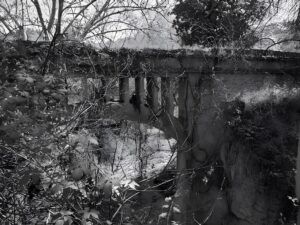
«The Cascade» with a parabolic arch was built by Antoni Gaudí in 1883 for the garden of Casa Vicens in Barcelona. This house was his first major project (1883-1888), clearly influenced by oriental and Andalusian architecture, which fascinated the architect at a time when “Arab salons” (rooms decorated in neo-Arab fashion) were proliferating in the city. With it, Gaudí overcame the influence of his teachers, who championed Historicism and Romanticism. It evokes the well-known Palladian villas, i.e. the houses of the 15th-century estate owners (with real rights over the property such as: ownership, usufruct, servitude, mortgage, pledge, antichresis, emphyteusis and census) that met the need for a new type of rural residence, effective in terms of establishing a social and political presence in the countryside, and appropriate for rest, hunting and to escape from the city, which was always potentially unhealthy. I have no doubt that Gaudí was inspired by the Alhambra’s Blissful Garden (Jardín Feliz), now known as the Palace of the Lions (Palacio de los Leones), when he conceived the architectural project for Casa Vicens in keeping with the aforementioned requirements. Muḥammad V was the person behind this beautiful palace built during his second reign, between 1362 and 1391, as an intimate space formed by two gardens, one natural –the Courtyard of Lindaraja–, and the other imaginary –the Courtyard of the Lions, with its four “rivers” and multiple fountains whose waters irrigate palm trees, vines and pomegranate trees displaying their fruit in the vertical garden carved in the marble of its columns and the plaster of its vertical walls and surfaces. All of this connects the architecture with Nature while evoking the Garden of Eden. A palace such that, if its history speaks in the past, its biophilic architecture speaks in the present, as an example of a sustainable, energy-efficient, healthy construction with a high degree of comfort. These characteristics, most of which coincide with those of Palladio’s villas, mean that we can consider the Palace of the Lions as a reference point for the conception of Casa Vicens. Specifically, the gazebos jutting into the Courtyard of the Lions are two qubbas from which to view the “garden” and, above all, the Fountain of the Lions. Their columns and arcades, integrated into the peristyle of the courtyard, evoke both the outer decoration of Casa Vicens and the interior of that house’s so-called Tribuna (enclosed balcony), from which the gaze was led to the Vincens garden, and directly in front of which was the Cascade. Thus, Casa Vicens partakes of biophilic architecture that is subject to the laws of Nature, providing sensory stimuli to those inside and allowing them to reconnect with Nature. Casa Vicens is Gaudí’s ideal house, his manifesto-house, and has been declared a UNESCO World Heritage Site. In another context, far from Barcelona is the Royal Dam that Muḥammad I had built to draw, from the right bank of the River Darro, the waters of the Acequia Real (Royal Irrigation Canal) with which to supply the Alhambra. After the conquest of Granada by the Catholic Monarchs, the Jesuits took over the land surrounding the Royal Dam. From 1554 onwards, they began to construct buildings to cultivate and take advantage of the resources that the land provided. Thus, half a kilometer downstream, they built the so-called King’s Mill (Molino del Rey). It is located at the point where the Acequia Real crosses the River Darro and from there onwards, runs along the left slope of the valley that channels the river. It does so by means of an aqueduct along the top of which was a canalón or wooden conduit waterproofed with a mixture of pitch, lime, tow and bits of ground glass that served to cover the joints between the different sections. The look of this aqueduct evokes the image of Gaudí’s Cascade. Once again, the water of the Alhambra is linked to that of Barcelona. Its color is golden, like the gold that was extracted from the River Darro near the King’s Mill or like that of the bars (i.e. stripes) on the Catalan flag. The color of the water is Alhambra and Barcelona.
